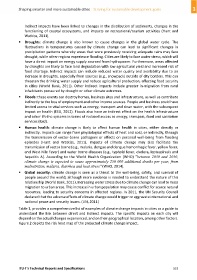Page 563 - Shaping smarter and more sustainable cities - Striving for sustainable development goals
P. 563
Indirect impacts have been linked to changes in the distribution of sediments, changes in the
functioning of coastal ecosystems, and impacts on recreational/tourism activities (Hunt and
Watkiss, 2011).
Droughts: climate change is also known to cause changes in the global water cycle. The
fluctuations in temperatures caused by climate change can lead to significant changes in
precipitation patterns whereby areas that were previously receiving adequate rains may face
drought, while other regions experience flooding. Cities are likely to face water stress, which will
have a direct impact on energy supply sourced from hydropower. Furthermore, areas affected
by droughts are likely to face land degradation with low agricultural yield and increased risk of
food shortage. Indirect impacts can include reduced water quality and availability due to an
increase in droughts, especially from sources (e.g., snowpack) outside of city borders. This can
threaten the drinking water supply and reduce agricultural production, affecting food security
in cities (World Bank, 2011). Other indirect impacts include greater in‐migration from rural
inhabitants pressured by drought or other climate extremes.
Floods: these events can destroy homes, business sites and infrastructure, as well as contribute
indirectly to the loss of employment and other income sources. People and business could have
limited access to vital services such as energy, transport and clean water, with the subsequent
impact on health (EEA, 2012). Floods also have an indirect effect on the health infrastructure
and other lifeline systems in terms of reduced access to energy, transport, food and sanitation
services (ibid).
Human health: climate change is likely to affect human health in cities, either directly or
indirectly. Impacts can range from physiological effects of heat and cold, or indirectly, through
the transmission of vector‐borne pathogens or effects on personal well‐being from flooding
episodes (Hunt and Watkiss, 2011). Impacts of climate change may also facilitate the
transmission of vector borne (e.g., malaria, dengue and dengue hemorrhagic fever, yellow fever,
and West Nile Fever) and water borne diseases (e.g., typhoid fever, cholera, leptospirosis and
hepatitis A). According to the World Health Organization (WHO) "between 2030 and 2050,
climate change is expected to cause approximately 250 000 additional deaths per year, from
malnutrition, malaria, diarrhea and heat stress" (WHO, 2014).
Global security: climate change is seen as a threat to the well‐being, safety, and survival of
people around the world, although more evidence is needed to understand the nature of this
relationship (World Bank, 2011). Increasing water stress due to climate change can lead to mass
migration to urban areas. This increase in urban population may cause conflict for scarce natural
resources, leading to security concerns in affected regions. In 2011, the UN Security Council
declared that the adverse effects of climate change would trigger or aggravate international and
national peace and security issues. (UN, 2011)
Table 1, provides a comprehensive list of examples of climate change impacts in cities as a guide to
understand the link between direct and indirect impacts. The specific impacts on each city will
depend on the actual changes experienced, and on their geographical location, among other factors.
Figure 2 depicts the risk heat map of the projected climate change impact.
ITU‐T's Technical Reports and Specifications 553

